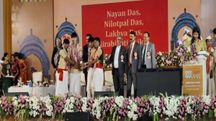IIIT-Hyderabad develops a mortality prediction model for COVID-19 Patients in India
 IIIT-Hyderabad develops a mortality prediction model for COVID-19 Patients
IIIT-Hyderabad develops a mortality prediction model for COVID-19 PatientsHYDERABAD: The International Institute of Information Technology Hyderabad (IIIT H) has developed a Mortality Prediction Model to aid in the prioritisation of healthcare focusing on uncertainty and mortality predictions.
The researchers of IIIT-Hyderabad came up with the model at a time when the country is facing a serious COVID resource shortage.
IIITH researchers demonstrate how machine learning (ML) models can assist in prioritising healthcare based on risk and mortality prediction.
ALSO READ: Nearly 100 million years old Dinosaur bones discovered in Meghalaya
Researchers from IIITH used ML models to categorise risk and predict mortality in Indian COVID patients as part of a joint sponsored by Intel Corp under its pandemic Response Technology Initiative with the Council of Scientific and Industrial Science and Institute of Genomics and Integrative Biology (CSIR-IGIB ).
Akshaya Karthikeyan is the lead author of the paper titled “Machine Learning-Based Clinical Decision Support System For Early Covid-19 Mortality Prediction”
Akshaya and her team identified five biomarkers that can be used to predict mortality with 96 percent accuracy using the same dataset of COVID positive patients from Wuhan. Early prediction, according to these researchers, will aid healthcare practitioners in making appropriate treatment decisions faster.
According to Akshaya, they have attempted to predict mortality as early as 16 days before the result.
Although many algorithms provide useful information, the biggest flaw is that they were trained using patient data from either China or the United States.
ALSO READ: CM elect Himanta Biswa Sarma extends his deepest gratitude to Assam people
The CCNSB researchers conducted an India-specific analysis – this time on 544 COVID positive patients from the MAX group of hospitals in New Delhi in order to correct this flaw.
Putting out a disclaimer that the study (which is currently under peer review) was performed during the first wave of the pandemic in India, Shanmukh Alle, the project's lead researcher, says that in addition to predictive modeling for the Indian population, they also wanted to explore possible reasons behind Indians' lower mortality rate than China.
The researchers first put Akshaya's neural network to the test on the Indian dataset. They discovered that, unlike the high (96%) accuracy of mortality prediction shown in the early stages of COVID-19 diagnosis, Indian mortality could only be predicted with a 58 percent accuracy. But one of the most puzzling findings was that high-risk Indian patients who were supposed to die based on the Wuhan dataset actually survived.
ALSO READ: Karimganj’s COVID-19 tally crosses 5200 mark with 92 more fresh cases reported today
Shanmukh said it was discovered that the use of steroids is linked to mortality. This is consistent with the Indian government's early treatment protocols, which required the use of steroid and immunosuppressive drugs. Predicting a patient's risk, i.e., whether they are high-risk or low-risk based on the amount of respiratory support required (if any), is important for efficiently allocating limited resources.
Blood parameters, oxygen saturation levels, and diabetes comorbid conditions were established as biomarkers in this study.
Only blood parameters were taken into account when predicting mortality. For risk stratification and mortality prediction, two separate machine learning methods were used, with excellent results in both cases.
Copyright©2025 Living Media India Limited. For reprint rights: Syndications Today









